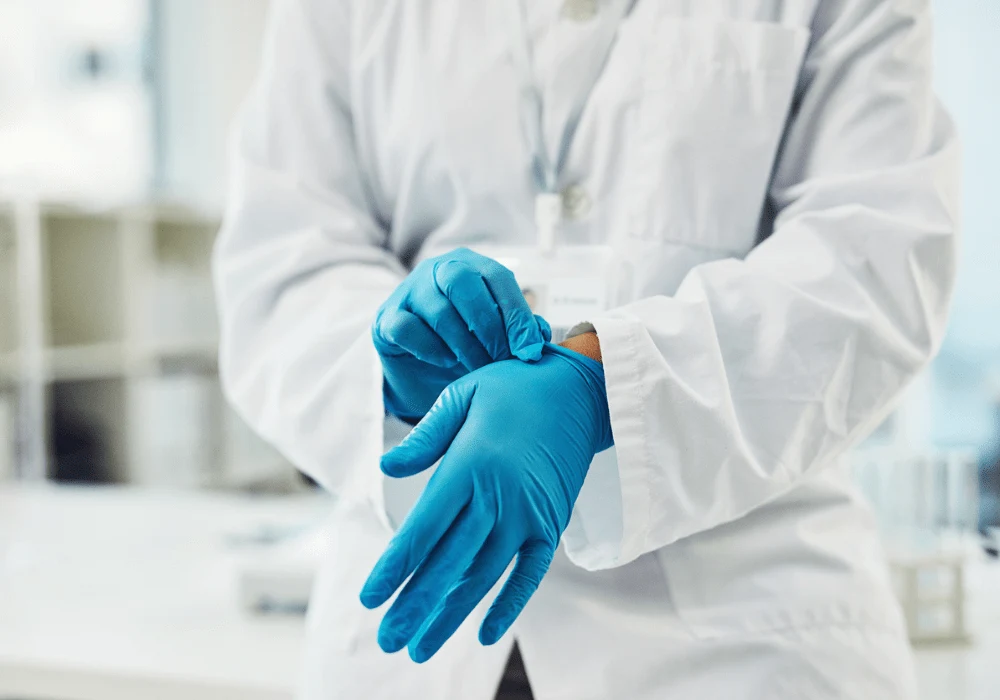Image capture: Scientist or medical professional putting on protective gloves in a laboratory setting
The threat of substandard and counterfeit medical devices is an escalating concern within the healthcare industry. Ranked fourth in ECRI’s Top 10 Healthcare Technology Hazards for 2025, this issue jeopardises patient safety, compromises clinical outcomes and imposes significant operational and financial burdens on healthcare organisations. Recent incidents involving faulty syringes, isolation gowns, counterfeit diabetes testing devices and infusion pump batteries have underscored the urgency of addressing this pervasive problem. Tackling the issue requires a systemic approach, combining vigilance, strategic sourcing, staff training and regulatory advocacy.
The Scope and Impact of Counterfeit Medical Products
High-profile examples reveal the wide-ranging consequences of substandard and counterfeit medical devices infiltrating the supply chain. Faulty syringes manufactured in China have drawn multiple FDA safety alerts, with more than one billion affected products potentially compromising patient care through inaccurate measurements, plunger malfunctions and contamination. Simultaneously, tests on isolation gowns distributed over recent years have shown a failure to meet basic safety requirements, exposing healthcare professionals to infectious hazards.
The problem extends beyond protective equipment. Counterfeit diabetes testing devices circulating in online marketplaces have led to dangerously inaccurate readings, posing severe health risks, including diabetic ketoacidosis and cardiovascular complications. Equally alarming are counterfeit infusion pump batteries, which carry threats such as overheating, leakage and inaccurate medication delivery. These examples collectively highlight the multifaceted dangers posed by fraudulent or substandard equipment and the widespread implications for patient safety, clinical accuracy and operational efficiency.
Recommended Read: Strengthening Healthcare Supply Chain Resilience
Challenges in Securing the Healthcare Supply Chain
Ensuring the quality and authenticity of medical devices is increasingly difficult due to several compounding challenges. The complexity of global supply chains is a primary concern. A wide network of vendors operating under differing regulatory frameworks creates inconsistencies in manufacturing standards and product oversight. During periods of supply shortage, healthcare facilities may be forced to rely on underregulated or unfamiliar third-party vendors, inadvertently introducing counterfeit products into their systems.
A lack of transparency across supplier operations compounds the problem, as many organisations cannot verify the full lineage or quality assurance practices behind the products they purchase. Moreover, underreporting of product defects—especially those that have not yet caused patient harm—limits the ability to detect systemic issues and initiate timely interventions. Delays in safety notices, often due to the absence of advanced monitoring tools, can further prevent healthcare providers from promptly identifying and removing compromised items from use.
Another significant issue is the inconsistent enforcement of quality controls by regulatory bodies across different regions. In areas where oversight mechanisms are weak or underfunded, counterfeit products can more easily enter the market and circumvent detection. These gaps in enforcement create vulnerabilities that undermine the overall safety and reliability of the global healthcare supply chain.
Strategies for Risk Mitigation and Quality Assurance
To protect against the infiltration of substandard and counterfeit devices, healthcare organisations must adopt a multifaceted strategy grounded in prevention, detection and collaboration. One critical step is implementing a rigorous supplier evaluation process. This includes procuring equipment directly from trusted manufacturers or vetted distributors and conducting periodic audits to ensure ongoing compliance with regulatory standards. Avoiding consumer-facing e-commerce platforms when sourcing medical devices can also reduce exposure to unauthorised products.
Product testing prior to procurement is another essential safeguard. Organisations should establish formal testing protocols, particularly for products from new or unfamiliar suppliers, and involve clinicians and end-users in assessing product performance. Collaborations with independent testing bodies can further validate product quality and identify potential risks before devices reach patient care areas.
Strengthening supply chain integrity also involves enhancing traceability. The use of tamperevident packaging, barcoding, serial number verification and RFID technologies allows for the tracking of products throughout their lifecycle, making it easier to detect and isolate problematic items. In parallel, organisations should develop clear internal protocols for incident reporting. Encouraging staff to report even minor defects ensures timely investigations and supports external reporting to manufacturers, regulators and safety monitoring bodies.
Education and training form the foundation of organisational vigilance. Regularly updating healthcare staff on how to recognise signs of counterfeit or substandard equipment—such as unusual packaging or uncharacteristically low prices—empowers frontline workers to act quickly. Furthermore, engaging with industry groups and regulatory agencies to support stronger manufacturing and distribution standards contributes to a broader culture of safety and compliance.
The rise of substandard and counterfeit medical devices presents a formidable challenge to healthcare organisations worldwide. However, through comprehensive strategies focused on supplier scrutiny, robust product testing, enhanced traceability and staff education, these risks can be significantly mitigated. Proactive engagement with regulatory and industry stakeholders further strengthens efforts to create a resilient and trustworthy supply chain. By reinforcing each link in this chain, healthcare providers can protect patients, support clinical outcomes and maintain the integrity of their operations, ensuring that safety remains at the core of care delivery.
Source: ECRI
Image Credit: iStock










